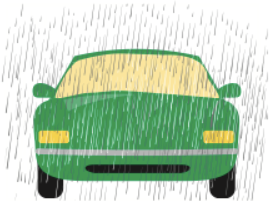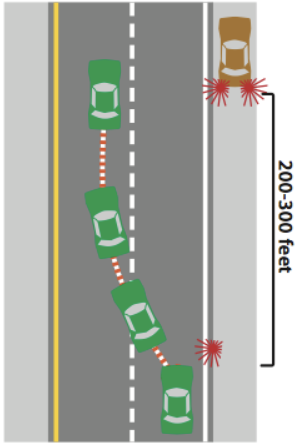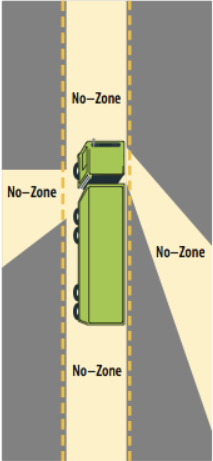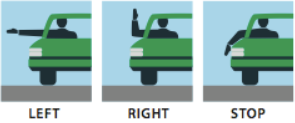Session 21 – Communicating with Other Drivers
COMMUNICATING WITH OTHER DRIVERS
Crashes often happen because one driver does not see another driver, or when one driver does something another driver does not expect. It is important for you to let other road users know you are there and what you plan to do.
Letting Others Know You Are There
Some drivers do not always pay attention to what is going on around them. It is important for other road users to know you are there.
Use headlights: Besides helping you see at night, headlights help other people see you at any time. Remember to turn on your headlights whenever you have trouble seeing others. If you have trouble seeing them, they will have trouble seeing you.
On rainy, snowy or foggy days, it is sometimes hard for other drivers to see your vehicle. In these conditions, headlights make your vehicle easier to see. A good rule to follow is; if you turn on your wipers, turn on your headlights.

Turn on your headlights when it begins to get dark. Even if you turn them on a little early, it will help other drivers see you.
Whenever it’s necessary to drive with your lights on, use your headlights. Parking lights are for parked vehicles only.
When driving away from a rising or setting sun, turn on your headlights. Drivers coming toward you may have trouble seeing your vehicle because of the glare. Your headlights will help them see you.
Daytime running lights: Some newer vehicles have headlights that are on anytime the vehicle is running. They are called daytime running lights. These lights make it easier for others to see the vehicle, even in daylight. It helps to reduce the chance of a crash. However, daytime running lights are not meant to replace the use of headlights for night driving or when it is foggy, raining or snowing. If your vehicle does not have daytime running lights, you can get the same effect by manually turning your headlights on. Just remember to turn them off when you turn the engine off.
Use your horn: People cannot see you unless they are looking your way. Your horn can get their attention. Use it whenever it will help prevent a crash. If there is no immediate danger, a light tap on the horn should be all you need. Give your horn a light tap:
- when a person on foot or on a bicycle appears to be moving into your lane of travel. However, pedestrians and bicyclists crossing at an intersection have the right-of-way. Do not use your horn in these instances, but do yield the right-of-way.
- when you are passing a driver who starts to turn into your lane.
- when a driver is not paying attention or may have trouble seeing you.
- when coming to a place where you cannot see what is
ahead: a steep hill, a sharp curve or exiting a narrow alley.
If there is danger, do not be afraid to sound a SHARP BLAST on your horn. Do this:
- when another vehicle is in danger of hitting you.
- when you have lost control of your vehicle and are moving towards someone.
When NOT to use your horn: There are several occasions when you should not use your horn. They include:
- encouraging someone to drive faster or get out of the way.
- informing other drivers of an error.
- greeting a friend.
- around blind pedestrians.
- around animal-drawn vehicles or animals being herded on the roadway.
Use emergency signals: If your vehicle breaks down on a highway, make sure other drivers can see it. All too often, crashes occur because a driver did not see a stalled vehicle until it was too late to stop.
Try to warn other road users that your vehicle is there. Place emergency flares or triangles behind it. This allows other drivers to change lanes if necessary.

If available, use your 2-way radio or cellphone to notify authorities that your vehicle or another has broken down. Many roadways have signs that tell you the CB channel or telephone number to call in an emergency. If you are having vehicle trouble and have to stop:
- get your vehicle off the road and away from traffic, if at all possible.
- turn on your (4-way) emergency flashers to show you are having trouble.
- try to stop where other drivers have a clear view of your vehicle if you cannot get completely off the road. (Do not stop just over a hill or just around a curve.)
- stand by the side of the road where you are safe from traffic, if you do not have emergency flares or other warning devices.
- never stand in the roadway. Do not try to change a tire if it means you will be in a traffic lane.
- raise the hood or tie a white cloth to the antenna, side mirror or door handle to signal an emergency.
Stay out of the blind spot: Drive your vehicle where others can see you. Do not drive in another vehicle’s blind spot.
Try to avoid driving in the area on either side of and slightly to the rear of another vehicle where you will be in their blind spot. Either speed up or drop back so the other driver can see your vehicle more easily.
When passing another vehicle, get through the other driver’s blind spot as quickly as you can. The longer you stay there, the longer you are in danger because they may not see you.
Never stay alongside or right behind a large vehicle such as a truck or bus. Many drivers think truck drivers can see the road better because they sit twice as high as the driver of a car. While truckers can see ahead better, and trucks have bigger mirrors, they have very serious blind spots. A car can disappear from their view while it is up to 20 feet in front of the cab, on either side of the truck (especially alongside the cab), and up to 200 feet behind! These areas are all part of what is called the “No Zone”.

Drivers who travel in the “No Zone” restrict a trucker’s ability to take action to avoid a dangerous situation—and the possibility of a crash is increased. A good rule of thumb for drivers sharing the road with a truck or bus is, if you can’t see the truck or bus driver in their side mirror, they can’t see you.
Letting Others Know What You Are Doing
Generally other drivers expect you to keep doing what you are doing. You must warn them when you are going to change direction or slow down. This will give them time to react, if needed, or at least to not be surprised by what you do.
Signal when you change direction: Signaling gives other drivers time to react to your moves. You should use your turn signals before you change lanes, turn right or left, merge into traffic or park.
Get into the habit of signaling every time you change direction. This includes signaling before beginning to pass another vehicle, and before completing the pass. Signal even when you do not see anyone else around. It is easy to miss someone who needs to know what you are doing.
Signal 100 feet before your intended turn. Be careful that you do not signal too early, though. If there are streets, driveways or entrances between you and where you want to turn, wait until you have passed them to signal.
If another vehicle is about to enter the street between you and where you plan to turn, wait until you have passed it to signal your turn. If you signal earlier, the other driver may think you plan to turn where they are and they could pull into your path.
After you have made a turn or lane change, make sure your turn signal is off. If you don’t, others might think you plan to turn again.
Signal when you slow down: Your brake lights let people know that you are slowing down. Always slow down as early as it is safe to do so. If you are going to stop or slow down at a place where another driver may not expect it, quickly tap your brake pedal 3 or 4 times to let those behind you know you are about to slow down. Signal when you slow down:
- to turn off a roadway which does not have separate turn or exit lanes.
- to park or turn just before an intersection. Traffic following
you may expect you to continue to the intersection. - to avoid something in the road, or for stopped or
slowing traffic that a driver behind you cannot see.
Hand signals: Sometimes, in addition to using your turn signals, hand and arm signals may be used. An example would be when bright sunlight can make it hard for other drivers to see your flashing turn signals, or when driving an antique vehicle (one manufactured before July 1, 1958) that may not be equipped with turn signals. When using hand and arm signals, these are the standard positions:
- Left turn: hand pointing straight out
- Right turn: hand pointing up
- Stop or slow down: hand pointing down

